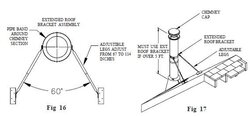Danno77
Minister of Fire
Gotta use one once you are over 4ft. Think it's like 75 bucks from a big box store, can't remember. Just make some measurements and get it to at least 15 ft for now from the stove top. If you have the cash more chimney is better (up to a point, as was said before)
Edit: darn it, didn't see replies on the next page. Hope his estimation of price is closer than mine.
Edit: darn it, didn't see replies on the next page. Hope his estimation of price is closer than mine.


 . It will need a roof brace too.
. It will need a roof brace too. 
